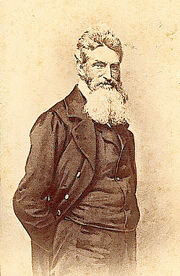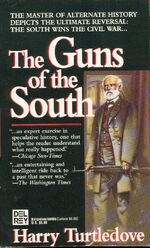| ||||||||||||||||||||||||||||||||||
John Brown (May 9, 1800 - December 2, 1859) was an American abolitionist in the period before the American Civil War. A militant opponent of slavery who made even Frederick Douglass look tepid by comparison in his dedication to the cause, Brown raised a militia during the conflict in Kansas known as Bleeding Kansas in the 1850s.
In 1859, he led a raid on the US armory in Harpers Ferry, Virginia (now West Virginia), hoping to capture enough weapons to arm a slave army which could wage a guerrilla war against the US. His band of raiders were defeated and captured or killed by a United States Army detachment commanded by Robert E. Lee.
Subsequently, Brown was tried, found guilty, sentenced to death, and hanged on December 2, 1859. He did not deliver any last words from the gallows, but he did hand his executioner a note reading:
"I, John Brown, am now quite certain that the crimes of this guilty land will never be purged away with blood. I had, as I now think, quite vainly flattered myself that without very much bloodshed it might be done."
The execution of John Brown, and the events preceding it, foreshadowed the Civil War.
Literary comment[]
The above happened in all Harry Turtledove timelines with a Point of Divergence after 1859. It is germane only to a few.
John Brown in The Guns of the South[]
After President-elect Robert E. Lee had studied a time-displaced copy of The American Heritage Picture History of the Civil War which a soldier had stolen from the Rivington Men, he had a meeting with Andries Rhoodie, their leader. Lee's contention that Rhoodie had not been completely honest with the Confederates was not appreciated by him but Rhoodie became truly angry when Lee asserted that Rhoodie was out of step with his own time as John Brown had been in his.[1]
Later, after the Richmond Massacre, President Lee arranged for a series of presentations for Confederate Congressmen and Senators to examine the documents recovered from the AWB offices. To Lucius Q.C. Lamar's query of how the Rivington Men fit into the future "love feast" between Negroes and whites, Lee replied "Poorly". He then hastened to repeat the analogy of their fit to that of Brown's, this time to a thoughtful silence.[2]
John Brown in Southern Victory[]
During his life, John Brown's support among even the most hardened radical-abolitionists had been tepid, and most in the Northern states opposed his violent campaigns. During the War of Secession, however, Brown came to be considered something of a folk hero and even a prophet who was ahead of his time in his identification of the South (the future Confederacy) as a threat. Union soldiers sung a song, "John Brown's Body," in his honor. His stature grew after the Confederate States won independence. Naturally, the Confederate States did not hold Brown in high esteem.[3]
After the United States lost the Second Mexican War, Brown was revered by the Remembrance philosophy of the Democratic Party, which was, ironically, a party he had opposed when alive. In particular, Theodore Roosevelt was one of Brown's admirers.
In fact, Roosevelt, after becoming President, said this about John Brown in a speech:
- "By jingo, it's always a pleasure for me to be in Kansas. This state was founded by men and women who knew a Southern viper when they saw one, even before the War of Secession. There is a man who knew who the enemy was, and a man who hit our country's enemies hard even when they still pretended to be friends. For that I am proud to salute him."[4]
See Also[]
- John Brown at the Eric Flint Wiki
- Edwin Coppock, one of Brown's raiders
References[]
- ↑ The Guns of the South, pg. 435, PB.
- ↑ Ibid, pg. 487.
- ↑ See, e.g., How Few Remain, pg. 370, pg.
- ↑ Blood and Iron, pg. 345, pb.
| |||||||||||||||||||












